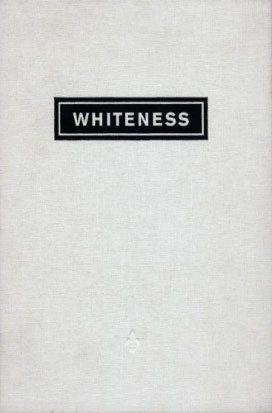Whiteness:
A Wayward Construction
 Whiteness, A Wayward Construction is a group exhibition of contemporary artists who explore the identity politics and
cultural study of whiteness in the United States, the first exhibition of its kind in an American museum. The exhibition includes
seventy-eight works of paintings, drawings, photography, and installations by twenty-eight artists.
Whiteness, A Wayward Construction is a group exhibition of contemporary artists who explore the identity politics and
cultural study of whiteness in the United States, the first exhibition of its kind in an American museum. The exhibition includes
seventy-eight works of paintings, drawings, photography, and installations by twenty-eight artists.
The exhibition is more about the image of whiteness in the public imagination and in contemporary art, and less an analysis of
particular historical developments. It approaches whiteness as being about an ideology of power. The term wayward in the exhibition
title is meant to suggest a double-meaning: the wayward, or capricious, power that whiteness confers and also the actual
ungovernableness and unpredictability that will deter any real attempt to pin a singular, overarching identity on an individual.
The ultimate goal of this cultural study and of this exhibition is to simply recognize the United States as a multicultural nation,
where whites, as cultural theorist Lucy Lippard writes, “will be encouraged to see themselves as simply another ‘Other.’”
Almost all of the artworks selected for the exhibition were created between 1990 and the present. This period coincides with a
particular development in the contemporary art world as artists and critics responded to the emergence of intellectual movements
such as poststructuralism, postcolonialism, and multiculturalism, from which the cultural study of whiteness arose in the 1990s.
Most fittingly, the majority of the artists in the exhibition are based in California, a state poised to cross the threshold into being a white-minority society.
The exhibition is subdivided into three overlapping categories that move from the general to the specific and are meant to suggest a
movement from unawareness, to reflection, to problematizing the white person as a racial subject.
CATALOGUE
A cloth-bound catalogue with 156 pages, 58 illustrations, and four essays accompanies the exhibition. The “White Out” section is
introduced by David R. Roediger is Babcock Professor of History at the University of Illinois, Urbana-Champaign. He is the author
of Colored White: Transcending the Racial Past (2002), among others. The “Mirror, Mirror?”
section is introduced by Amelia Jones, Professor of Art History at University of California, Riverside. She has written numerous
articles in anthologies and journals and has organized exhibitions, including Sexual Politics: Judy Chicago's Dinner Party in
Feminist Art History at the UCLA/Armand Hammer Art Museum (1996), for which she also edited and contributed to a catalogue by
the same title. The “Graying of Whiteness” section is introduced by Ken Gonzales-Day, associate professor of art at Scripps
College, Claremont, California. Recent articles and reviews have appeared in Art Issues; Art Journal; Art Papers; ARTpress;
and Art & Text. He is currently working on a book on the history of lynching in California.
Tyler Stallings, the exhibition curator, also organized Cyborg Manifesto, or the Joy of Artifice (2001); Sandow Birk's “In Smog and
Thunder: Historical Works from the Great War of California” (2000) for Laguna Art Museum. He has also organized Rubén Ortiz Torres:
Desmothernismo (1998, traveled); and Kara Walker: African't (1997); among others. He is also the co-editor of the anthology,
Uncontrollable Bodies: Testimonies of Identity and Culture (Seattle: Bay Press, 1994).
SOURCE
Berlin: Lit, 2010.
ISBN-10: 0911291318
ISBN-13: 978-0911291315